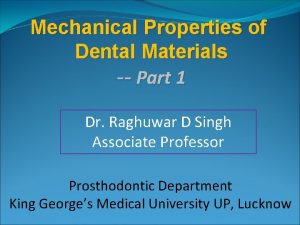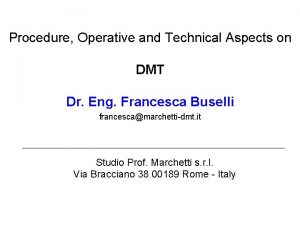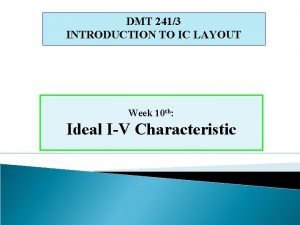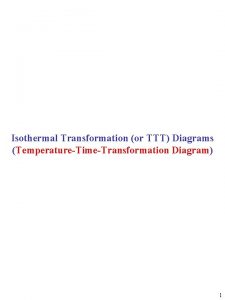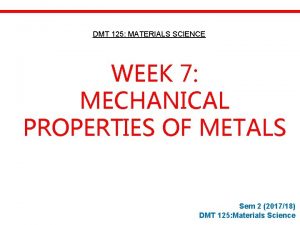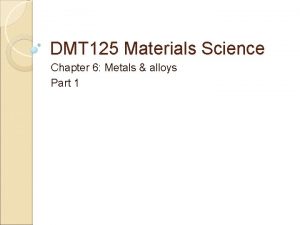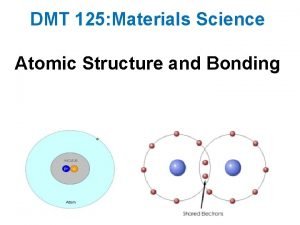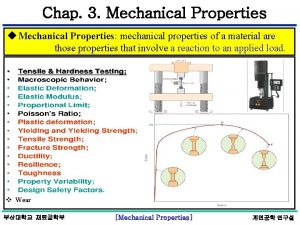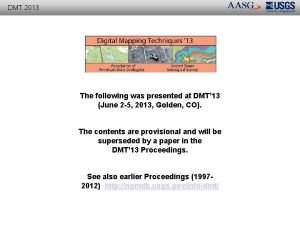DMT 125 Materials Science Chapter 5 Mechanical Properties

















- Slides: 17

DMT 125 Materials Science Chapter 5: Mechanical Properties Part 2

Fracture of metals Failure ◦ Inability of a material or a component to Perform intended function Meet performance criteria although it may still be operational Perform safely & reliably even after deterioration ◦ Examples Yielding Wear Buckling (elastic instability) Corrosion fracture

Fracture of metals Every engineer should ◦ Completely familiar with concept of fracture or failure of materials ◦ Able to extract info from a failed component as to the causes of failure Fracture ◦ Separation of a solid under stress into two or more parts ◦ Classified into 2 types ductile Occurs after extensive plastic deformation & characterized by slow crack propagation Brittle Usually proceeds along characteristic crystallographic planes called cleavage planes & has rapid crack propagation Ductile – plastic deformation maybe detectable Brittle – lead to sudden, unexpected catastrophic failures

Fracture of metals Ductile fracture ◦ Occurs after extensive plastic deformation ◦ If a stress is applied that exceeds its ultimate tensile strength & sustained long enough, it will fracture ◦ 3 distinct stages Specimen forms a neck, & cavities form within the necked region Cavities in the neck coalesce into a crack in center of specimen & propagate toward surface in direction perpendicular to applied stress When crack nears the surface, direction of crack changes to 45 degrees to tensile axis & a cup-and-cone fracture results

Fracture of metals In practice, ductile fractures are less frequent than brittle fractures Overloading occurs by ◦ Improper design ◦ Improper fabrication ◦ Abuse (components used at load levels above that allowed by designer)

Fracture of metals

Fracture of metals Brittle fracture ◦ Usually proceeds along specific crystallographic planes (cleavage planes) under a stress normal to cleavage plane ◦ HCP crystal structure commonly show brittle fracture because of their number of slip planes ◦ BCC metals (alpha iron, molybdenum & tungsten) also fracture in a brittle manner at low temperatures & high strain rates

Fracture of metals

Fracture of metals Most are transganular ◦ Cracks propagate across the matrix of grains Can also occur in an intergranular manner if grain boundaries contain a brittle film or if grain boundary region has been embrittled by segragation of detrimental elements 3 stages of brittle fracture ◦ Plastic deformation concentrates dislocations along slip planes at obstables ◦ Shear stresses build up in places where dislocations are blocked, and as a result microcracks are nucleated ◦ Further stress propagates the microcracks, and stored elastic strain energy may also contribute to the propagation of the cracks

Fracture of metals The defects commonly formed either during manufacturing stage or develop during service Ductile to brittle transition (DBT) ◦ transition from ductile to brittle behaviour

Fracture of metals Toughness & impact testing ◦ Toughness – measure of amount of energy a material can absorb before fracture ◦ Tested using an impact-testing apparatus

Fracture of metals

Fracture of metals DBT is important consideration for components that operate in cold environments Example ◦ Ships that sails in cold waters ◦ Offshore platforms located in Arctic seas

Fracture of metals Fracture toughness ◦ Starts at a place where the stress concentration is the highest Maybe at top of a sharp crack ◦ Y : dimensionless geometric constant on the order of 1 ◦ a : edge-crack length or half the length of an internal through crack ◦ : applied nominal stress ◦ Unit :

Fracture of metals

Fracture of metals Example 5

END Copyright © Mr. Mohd. Azarulsani b. Md. Azidin February 2011
 Longitudinal strain
Longitudinal strain Mechanical properties of materials
Mechanical properties of materials Mechanical properties of nano materials
Mechanical properties of nano materials Device physics
Device physics Dmt 234
Dmt 234 Physic
Physic Dmt
Dmt Semiconductor
Semiconductor Dmt dynasty models
Dmt dynasty models Dmt
Dmt Dmt fabrication
Dmt fabrication Layout dmt
Layout dmt Dmt monitor
Dmt monitor Population decline
Population decline Grade 4 natural science matter and materials
Grade 4 natural science matter and materials What are your favorite subjects
What are your favorite subjects Introduction to materials science for engineers chapter 10
Introduction to materials science for engineers chapter 10 Introduction to materials science for engineers chapter 10
Introduction to materials science for engineers chapter 10

